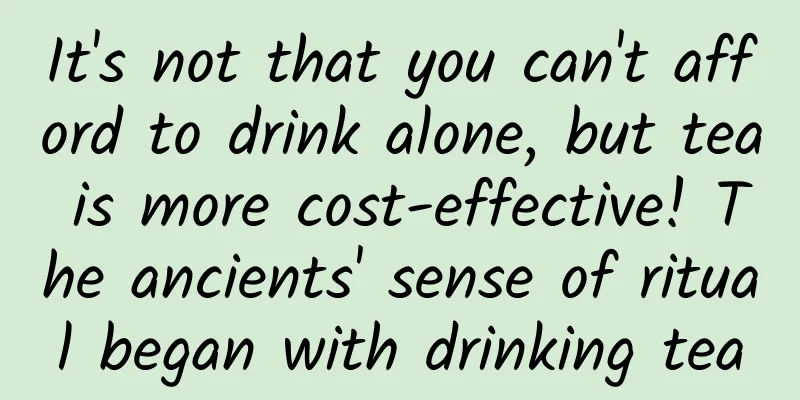It's not that you can't afford to drink alone, but tea is more cost-effective! The ancients' sense of ritual began with drinking tea

|
In daily life, do you prefer to make a cup of hot tea by yourself and enjoy the quiet and leisure, or invite friends to drink together under the pretext of tea? Su Shi, a great writer in the Song Dynasty, was a person who did not like to drink alone. Let's see how he invited friends to drink tea in "Tea Drinking Post". [Northern Song Dynasty] Su Shi's "Sipping Tea" Collection of the National Palace Museum, Taipei "Daoyuan, I have nothing to do. Can I just take a sip of tea now? If there is something, I must be clear-headed. Mengjian must be well! Please forgive me for being hasty." Su Shi, who loves tea, likes to invite his friends to drink tea when he has nothing to do. He writes a tea invitation: "Brother Daoyuan, you are free anyway, why don't you come over and have a cup of tea? We should meet to talk about some gossip." When you invite friends to drink tea and gossip, the slightly bitter and sweet taste of a hot cup of tea makes your body calm and gentle. The rubbing of tea creates a gentle friction on the taste buds, making the surrounding scene become gentle and honest, like a gentleman. Gathering over tea has been the first choice for Chinese people to socialize since ancient times; tea parties and elegant gatherings are also a form of tea culture in social life and interpersonal communication. Su Shi made a straightforward appointment for tea in his letter, so how much can we glimpse from the paintings of tea parties in the past dynasties about the exquisiteness of ancient people drinking tea? A tea party for monks and laymen Most of the famous mountains in the world are occupied by monks. The development of tea drinking in the Tang Dynasty was closely related to the monks in Zen temples. Tea drinking in the north was first started in Zen temples. Learning Zen requires staying awake, and tea has a refreshing effect, so it is widely spread in Zen temples. Take Yan Liben's "Xiao Yi Earns the Lanting Pavilion" from the Tang Dynasty as an example. It is a "Hongmen Banquet" about tea. [Tang Dynasty] Yan Liben's "Xiao Yi Earns the Lanting Pavilion" "Xiao Yi Earns the Lanting Pavilion" is the earliest known Chinese tea painting. It was created by the Tang Dynasty painter Yan Liben. The original has been lost. There are three existing copies of "Xiao Yi Earns the Lanting Pavilion" by Song Dynasty artists, which are respectively stored in the Palace Museum in Beijing, Liaoning Provincial Museum, and the National Palace Museum in Taipei. [Tang Dynasty] Part of "Xiao Yi Earns the Lanting Pavilion" by Yan Liben Here is a story: Emperor Taizong of Tang, Li Shimin, was a little fan of Wang Xizhi's calligraphy and searched for its authentic works. The only thing he didn't get was the "Lanting Preface", which is known as the best running script in the world. He asked Biancai (a disciple of Monk Zhiyong, the seventh-generation grandson of Wang Xizhi) for the "Lanting Preface" three times, but he was repeatedly denied. In desperation, he had to send Xiao Yi to get it. Xiao Yi asked Emperor Taizong of Tang for two scrolls written by Wang Xizhi, disguised as a down-and-out scholar who loved Xizhi's calligraphy, and appeared frequently. His outstanding character and conversation really attracted Monk Biancai. So Biancai invited him to drink tea and talk about Zen and chant poems, and gradually gained Biancai's appreciation and trust. He relaxed his vigilance during the tea drinking and deep chats, until Xiao Yi took out the two scrolls written by Wang Xizhi, and Biancai couldn't help but take out the "Lanting Preface" hidden on the beam to show off. As a result, Xiao Yi designed to take it away and presented it to Emperor Taizong of Tang the next day. This painting, "Xiao Yi Earns the Lanting Pavilion", depicts the scene of Bian Cai and Xiao Yi drinking tea and discussing the Dao. Bian Cai sits cross-legged on a Zen chair, and Xiao Yi, who is sitting opposite him, is calm and composed. What is Xiao Yi waiting for? Maybe he is waiting for the tea to be cooked, or maybe he is waiting for Bian Cai to take the bait. [Tang Dynasty] Part of "Xiao Yi Earns the Lanting Pavilion" by Yan Liben On the left side of the picture, an old servant and a boy are making tea. The old servant is squatting beside a stove with a pot on top. The water in the pot has been boiled and the tea has just been put in. The old servant is holding a "tea clip" to stir the "tea soup". On the other side, a boy is bending over, holding a tea tray, carefully preparing to "serve the tea". On the low table, there are other tea bowls, tea pots and other utensils. In the painting, Yan Liben shows a very typical method of brewing tea in the Tang Dynasty, that is, boiling tea powder in a pot. Lu Yu's Tea Classic has 24 utensils for drinking tea, and the picture shows 12 of them: wind furnace, bamboo pod, fire clamp, water cube, basket, salt bowl, set of utensils, cauldron, basin, towel, bowl, and gourd. This tea painting vividly reflects the tea-drinking life in the Tang Dynasty. In the painting, the monks in the temple not only drink tea, but also use tea to entertain guests. II Palace Tea Party In ancient times, tea parties were often divided into men and women. This can be seen from the following two tea paintings: Women's "Palace Music of the Tang Dynasty" 48.7×69.5cm Silk painting Collection of the National Palace Museum, Taipei From the "Palace Music Picture", we can see that the tea soup was put on the table after it was cooked. Before that, the procedures of preparing tea, roasting tea, grinding tea, boiling water, adding tea, and boiling tea should have been completed by the maids in another place; when drinking tea, the tea soup was scooped from the tea pot with a long-handled tea ladle and scooped into the tea cup for drinking. The tea cup is bowl-shaped with a ring foot, which is easy to hold. It can be said that this is a partial reproduction of the typical "tea cooking method" scene, and it is also one of the evidences of the prosperity of tea affairs in the court of the late Tang Dynasty. Eat when you should, drink when you should, and be fat if you want This tea is good! Tea doesn’t intoxicate people, but people themselves intoxicate. In addition to showing their talents, this women’s tea party also provided auditory and visual enjoyment, as well as taste and tactile experience. “Palace Music Picture” shows that tea drinking was closely integrated into the daily life and elegant art of the upper class at that time. Men's This was a gathering of some of the country's most outstanding scribes. [Northern Song Dynasty] Zhao Ji, "Literary Gathering", Collection of the National Palace Museum, Taipei "Literary Gathering" is a silk painting jointly created by Zhao Ji and court painters in the Northern Song Dynasty. It is now in the collection of the National Palace Museum in Taipei. It depicts the gathering of literati at that time. This is a rare masterpiece of tea ceremony and also a precious court gathering. Emperor Huizong of Song, Zhao Ji, loved tea all his life. He often entertained ministers and scholars with tea in the palace. Sometimes he would brew tea himself and compete in tea competitions for fun. He once wrote a tea book, Daguan Cha Lun, to discuss the tea ceremony. As a result, the custom of tasting tea became popular among the people of Song Dynasty. Detail of Literary Gathering In the painting, scholars are sitting around a table, talking to each other. The table is filled with various snacks for them to enjoy. Behind the tea table, there is another table between the flowers and trees, on which there is an incense burner and a zither. The whole process of making tea in the Song Dynasty is depicted in a prominent position, i.e., the front of the picture, in this "Qionglin Banquet". Different from brewing tea in the Tang Dynasty, making tea in the Song Dynasty means dripping. The cake tea should be ground into tea powder, poured into the cup and sipped. Detail of Literary Gathering The process of waiting for the tea, ordering tea, dividing the tea and serving the tea proceeds in an orderly manner. But the picture only stops at the moment of waiting for the tea and preparing to order the tea. The boy in the middle holds an empty cup in his hand, scooping tea leaves to put into the cup. There are three more cups on the table in front of him. There are two teapots on the tea stove, and the fire is burning, obviously boiling water and waiting for the tea. The boy holds the teapot on the side, intending to order the tea. A scholar seems to be thirsty, and personally brings a tray to the tea table to wait. At the bottom left of the painting sits a maid in green clothes and short hair, holding a tea bowl in her left hand and resting her right hand on her knees. Maybe she is very thirsty, or maybe she is tasting the tea, and she is drinking tea as if no one is around. The elegant scenery, coupled with the thoughtful tea-making and exquisite tea snacks, is definitely the ceiling of tea banquets in the Song Dynasty. This "Literary Gathering" also uses pictures to prove history and show the art of tea-making in the Song Dynasty. Three Tea Parties of Literati What do scholars pay most attention to when they drink tea? Let us travel back to the painting "Huishan Tea Party" to take a look. [Ming] Wen Zhengming, "Tea Party at Huishan", Collection of the Palace Museum, Beijing "Tea Party at Huishan" was painted by Wen Zhengming, one of the Four Masters of Ming Dynasty, more than 500 years ago. It shares the scene of him, Cai Yu, Wang Shou, Tang Zhen and others going to Erquan Pavilion to taste tea and compose poetry during the Qingming Festival. Their friendship became famous and is still envied today. In the painting, there are towering ancient pines and a tea party set up in the mountains and forests. Guests may stand under the trees and chat, or sit in the pavilion and take a rest. In the open space next to the pavilion, a boy is boiling water to make tea under the pine trees. Part of the Huishan Tea Party The people who arrived first bowed and greeted the people who arrived later in the distance, and the people who arrived later followed the little servant along the narrow path towards the tea table while chatting. Seeing how exhausted everyone was, it must be a bit hard to drink the tea! Of course, it was mainly the hard work of the little servants. I think these tables, stoves, and tea sets were all brought up from the foot of the mountain. Why choose Huishan to hold a tea party? This is related to the spring under the pavilion in the painting, and also to the ancient people's sense of ritual. Don't look at it as ordinary, it is Huishan Spring, which is known as the "Second Spring in the World". Part of the Huishan Tea Party The Ming people attached great importance to tea tasting, especially in Wuzhong area in the south of the Yangtze River, where famous teas and famous springs complemented each other, and literati led the fashion. Drinking tea is very particular about everything from selecting tea, using water, tea utensils, environment, tea tasting space and tea utensils, and even the number of people tasting tea. This kind of tea party for scholars, which is held in a small group among mountains and rivers, is pious and rigorous, just like a ritual to cleanse the soul. The elegant tea flavor revealed in this painting reflects the tea ceremony pattern of Ming Dynasty scholars advocating natural and fresh tea without losing the ancient style. From ancient times to the present, pictures have been used to learn from history. From the "tea-making" in the Tang Dynasty to the "tea-making" in the Song Dynasty, and then to the "tea-making" in the Ming and Qing Dynasties, tea parties have various forms. The inclusiveness and mutual integration of tea have created a harmonious atmosphere, coordinated and even enhanced the relationship between people, which has been verified one by one in tea paintings. the end Contributor: Teacher Di Ying from China Academy of Art Reviewer: Yu Liangzi, Senior Laboratory Scientist, Tea Research Institute, Chinese Academy of Agricultural Sciences The picture comes from the Internet |
<<: Interstellar Odyssey: A Guide to the Solar System's Planets in 2024
Recommend
How to quickly build a marketing and promotion system for 2B products
In the past two years, the SAAS product market ha...
How to use user tags to improve activity conversion rate?
In the field of operations , tags are usually a t...
IC Insights: Capital expenditures for the entire semiconductor industry are forecast to be around $146.6 billion in 2023, down 19% year-on-year
Memory chip manufacturers, including Micron and S...
Why do some people always pick their toes? And then smell them?
This article was reviewed by Tao Ning, PhD, Assoc...
IEA: Clean Energy Market Tracker March 2024
The IEA has released its "Clean Energy Marke...
iPhone 6s is close to perfection if it does these 6 things
Whether it is called "iPhone 6s/6s Plus"...
How to promote an event? 3 big steps!
Whether an activity can become popular has a lot ...
How many steps are needed to neatly fold three parachutes the size of basketball courts and put them into the return capsule?
The main parachute has an area of 1,200 square ...
Have you noticed the signs of "heart palpitations"? There are 4 heart conditions that may not be detected by routine examinations →
Put it in the past My heart suddenly started beat...
New media planning event promotion and operation tool library!
Marketing operations are inseparable from activit...
The risk of death dropped by 12%! Loving to post on WeChat Moments can actually make you live longer?
Do you like posting on Moments? Recently, many fr...
In summer, you must deworm your cats and dogs! But how to use toxic deworming medicine?
Summer is here, remember to deworm your pet regul...
Have cockroaches in Guangdong "evolved"? This speculation is unscientific!
According to Guangdong Radio and Television Stati...
Introduction to Huawei App Market paid promotion service!
1. Introduction to paid promotion business Relyin...









